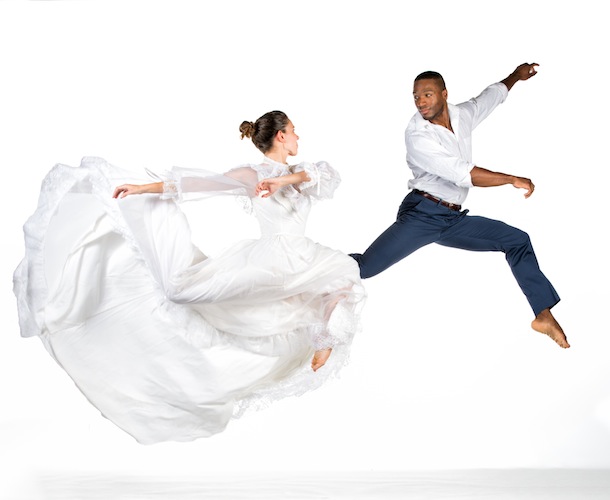Dance/Music Preview: Chorus pro Musica’s Spring “Wedding” — A Marriage of Music and Dance
Chorus pro Musica music director Jamie Kirsch describes Les Noces as “a non-stop, energetic, tour-de-force ride that lasts 25 minutes without a break and leaves you breathless by the end.”
Les Noces (The Wedding), performed by Chorus pro Musica and BoSoma Dance Company at Jordan Hall, Boston, MA, at 8 p.m. on May 30.

BoSoma Dance Company performing “Les Noces” with Chorus pro Musica. Photo: Anthony Mistretta.
By Merli V. Guerra
Capping its 66th season in Boston, the celebrated ensemble Chorus pro Musica will not only bring its musicians and vocalists to the stage, but local dancers as well. The ambitious evening will range the gamut — from folk songs for children to Stravinsky’s masterpiece Les Noces. The latter will feature new choreography by BoSoma Dance Company, bringing two local establishments together in this zesty season closer.
“Les Noces was conceived by Stravinsky as a ballet, but it is most often performed without dancers in concert today,” explains music director Jamie Kirsch. “Chorus pro Musica loves to collaborate with other Boston arts organizations, and this was a great opportunity for this.”
The partnership between Chorus pro Musica and BoSoma first began more than a year ago last spring. The result is now a real and metaphoric marriage of music and dance perfectly suited for Les Noces (The Wedding).
BoSoma Dance Company is headed by co-founders and choreographers Katherine Hooper and Irada Djelassi. A Boston staple since 2003, the contemporary dance company is known for its dancers’ powerful energy and dynamic strength.
“Back in March of 2014, Jamie reached out to us to see if BoSoma would be interested in taking on this project,” recalls Hooper and Djelassi. “We were extremely excited by the opportunity to collaborate with another well-established performing arts organization in Boston.” Yet as the two began to dig deeper into the work they were about to embark on, the magnitude of the project became clear. “After doing research on Les Noces, we realized it would be a big task to take on; however, we were thrilled with the challenge of the piece.”
This isn’t the first time Stravinsky’s composition has inspired a dance and music collaboration. Les Noces was first presented in 1923 by ballet impresario Serge Diaghilev. Bronislava Nijinska’s choreography for the work was performed by the Ballets Russes. Nijinska was a visionary artist in a number of ways, encouraging the dance world to set aside 19th-century Classicism and support the Neoclassical movement instead.
Now, nearly 100 years later, motion and melody are once again coming together in a performance of Stravinsky’s work.
“It is exciting and absolutely inspiring to work with a live orchestra and chorus,” report Hooper and Djelassi. “We have been developing the piece for the past seven months to a recording conducted by Leonard Bernstein, and anticipate there will be some variation when the music is performed live. This is our first collaboration with Chorus pro Musica. It will be quite fulfilling to see it all come together on stage and experience how our dancers react to the energy of the chorus and musicians, offering a visceral experience for all in the theatre.”

Chorus pro Musica music director Jamie Kirsch in action Photo: Alonso Nichols/Tufts University.
The two companies are anxious to share the spotlight in this presentation: the goal is to highlight the strengths of each. To underline their collaborative approach, this production of Les Noces will reject the traditional placement of the musicians in the orchestra pit. The musicians as well as the singers will be onstage, right alongside the dancers. Despite the physical restrictions that this arrangement places on Hooper and Djelassi, the choreographers welcome the challenge of creating new work for an 8-by-22-foot semicircle apron, backed by 100 chorus members, percussion, and grand pianos. “Visually,” they explain, “[the orchestra] will become a part of the performance, almost like a set. Aesthetically, it will be a beautiful composition to experience.”
As for Kirsch, the work holds special meaning for the musicians: “Chorus pro Musica hasn’t performed Les Noces since the mid-’80s. It is well-known as one of the greatest achievements in choral music in the 20th century, and one of the most difficult pieces to perform because of its relentless rhythmic changes, and Russian language.”
Les Noces will be performed in the second half of the evening. The opening choral works have been chosen to explore the theme of weddings and the festivities of spring. Families will enjoy the inclusion of Chilcott’s Aesop’s Fables and Gregario’s Frog Went A-Courtin’.
Yet the highlight of the evening is without a doubt the music and movement mash-up posed by Les Noces, or as Kirsch describes the piece: “A non-stop, energetic, tour-de-force ride that lasts 25 minutes without a break and leaves you breathless by the end.”
Merli V. Guerra is a professional dancer with a background in ballet, modern, and classical Indian dance in the Odissi style, and an award-winning interdisciplinary artist with talents in choreography, filmmaking, writing, and graphic design. She is co-founder and artistic director of Luminarium Dance Company, production manager of Art New England magazine in Boston, and selects The Arts Fuse’s weekly coming attractions for dance.
Tagged: BoSoma Dance Company, Chorus pro Musica, Jamie Kirsch, Les Noces
